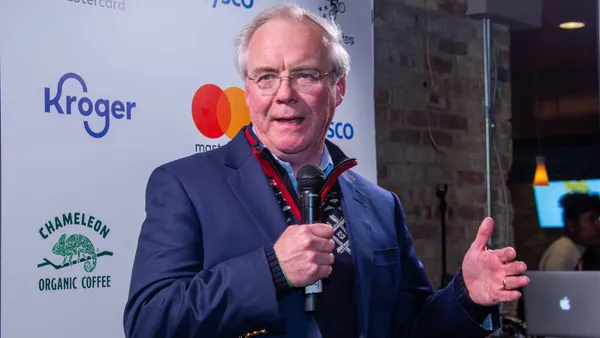Even as Kroger and Albertsons face continued uncertainty as they seek federal approval to merge, the supermarket companies’ high-profile saga is a sign that the grocery sector has entered a period of inevitable consolidation, according to industry analysts.
With just a handful of retailers dominating the grocery business in the U.S. and a significant number of smaller players battling for a share of the rest of the market, the industry has reached a point where supermarket operators are likely to feel strong pressure to join forces with one another in order to thrive, said Arun Sundaram, vice president of equity research for CFRA Research.
Sundaram added that while he was initially surprised that Kroger opted to try to buy its largest rival in the traditional supermarket space rather than scoop up smaller competitors, the complex merger plan is nonetheless a reminder that the grocery industry in the U.S. has reached a point where the only clear way for food retailers to grow is to join forces.
“The Kroger-Albertsons announcement was a wake-up call to all the other grocers out there that times are changing and they need to quickly adapt or get left out,” Sundaram said. “Even if the deal doesn’t go through, it's now in every CEO's head that this industry is consolidating and clearly wants to consolidate.”
Will more regionals and mid-size grocers combine?
Regional grocers have joined forces with each other in recent years in a bid to scale up and boost operational efficiencies, negotiating power with suppliers, and more. This includes Raley’s acquisition of Arizona-based Bashas’, the merger of Tops and Price Chopper, and Brookshire Grocery Company’s purchase of Reasor’s in Oklahoma.
Retail consulting firm McMillanDoolittle expects to see increased consolidation of independent and regional grocers to better compete against industry giants like Walmart, Amazon and Kroger, Amanda Lai, who manages the firm’s food retail practice and supports strategic planning, retail concept development, consumer research, and real estate analysis for retail clients, said in a recent company blog post.
Grocers can scale a retail footprint by buying a banner customers already know rather than creating a new banner or expanding a foreign banner into a new market, Lai said in an interview: “M&A is a great tactic in terms of expanding into [an] adjacent or a new market.”
But Bobby Gibbs, a partner in Oliver Wyman’s Retail & Consumer Goods team, is skeptical that mid-size grocers will opt for mergers to scale their store fleets.
“If you're going to merge two [grocers], you need to find those cost synergies.”

Bobby Gibbs
Retail & Consumer Goods team partner, Oliver Wyman
Gibbs, who consults with food retailers, noted that mid-size grocers are currently expanding their store counts primarily through openings as opposed to acquisitions.
When mid-size grocers combine, Gibbs said that integration can be a cumbersome process, with the combination of IT, human resources, merchandising and buying systems proving particularly challenging. The merger can also dominate executives’ focus and slow down work on other aspects of their operations, Gibbs said.
“If you’re going to merge two [grocers], you need to find those cost synergies,” Gibbs said, adding that retailers with different pricing or marketing strategies will need to decide whether or not they will continue with two different merchandising strategies.
Sundaram said he thinks conditions are ripe for large grocery chains to buy smaller chains, in part because of the challenges retailers with fewer resources face in standing up to their bigger rivals.
“There’s more pressure now for the smaller grocery chains to grow, and the way to quickly grow for smaller grocers is to be acquired,” said Sundaram.
Scott Mushkin, CEO of R5 Capital, said that while bringing Kroger and Albertsons together would position them to compete more effectively with other large grocers, the complexity of the transaction makes it a cautionary tale for other retailers as they evaluate potential M&A opportunities.
“While there’s likely to be a lot of synergies at Kroger and Albertsons when they merge, they just may burn through it all trying to upgrade the system with lower prices to compete with Walmart and Amazon,” Mushkin said. “So I think if I was going to give someone advice in the traditional space as far as M&A goes, it would be simplicity. You want to be able to do it pretty easily.”
Will more wholesalers jump into grocery retail?
The Kroger-Albertsons divestiture plan, if approved, would see C&S Wholesale Grocers more than triple its footprint of retail locations with the purchase of offloaded stores from the mega-merger.
Other wholesalers may also turn to acquisitions to grow a retail store business, Gibbs said.
“Being a wholesaler is a really tough position to make margin because you're being squeezed by the retailer and the supplier,” Gibbs said.
Wholesalers could buy independent operators or very small regional chains, especially ones already tied to the wholesaler’s existing logistics network, he said. By building up a retail business, wholesalers can drive more volume into their wholesale network and create a more steady demand for product, Gibbs said, as well as get wholesalers closer to the end-consumer for enriched customer data to help make them better sellers.
However, beefing up their fleet of stores can run the risk of alienating existing retail customers and of splitting executive attention, Gibbs said.

Sundaram said that while vertical integration among grocery retailers and wholesalers might offer some benefits, he doesn’t expect to see those kinds of combinations become a trend.
“I think you’ll see more grocery chains merging with grocery chains as opposed to wholesalers merging with grocery chains,” said Sundaram.
What about adjacencies like alternative revenue streams or digital innovation?
Grocers will likely opt to look inward at their own alternative revenue opportunities outside of their core retail business and then seek acquisitions that bolster those financial streams and build scale, Gibbs said. Grocers’ partnerships underway with third-parties are serving as learning opportunities for retailers to assess whether or not there’s a business case that supports a larger scale investment and in-house offerings, he noted.
Grocers may, for example, look to acquire companies tied to health and wellness, tech solutions and customer insights monetization — all of which are industries that provide valuable adjacent revenue.
Lai with McMillanDoolittle agrees that retail media, especially, is an area where retailers could see M&A opportunities.
“Increasingly, retailers are going to have to find ways to diversify their revenue streams in a way that broadens the reach beyond the core retail business as well as create competitive advantages,” Lai said.
While some grocers have acquired third-party e-commerce players in recent years, — H-E-B acquired Favor in 2018 and Target bought Shipt in 2017 — the e-commerce logistics players that are left are operating beyond grocery delivery, making it difficult for grocers to justify buying them, Gibbs said.
“I think many of [the e-commerce players] are too big and also the price for them would be higher for the grocer than it would be for other buyers with access to lower cost of capital,” Gibbs said.
Is now the time for specialty retailers to shine?
Mushkin said he thinks some of the most promising opportunities for grocery M&A going forward will involve ethnic and specialty grocers, because those retailers tend to be smaller and operate in corners of the market where companies like Amazon and Walmart don’t hold a commanding position.
“There’s a lot of small, independent ethnic grocers out there, where you could see some roll-up activity,” said Mushkin. “We’ve seen this already starting to take place, and my guess is it happens more, because that’s an area where there’s actually real growth potential.”
A prime example of M&A in the ethnic grocer space is Heritage Grocers Group’s acquisition earlier this year of Texas-based supermarket chain El Rancho Supermercado. Heritage was formed through the combination of California Hispanic grocery chain Cardenas Markets and Tony’s Fresh Market.
Mushkin noted that specialty grocers like Sprouts Farmers Market and The Fresh Market are expanding their store fleets — potentially positioning them as merger partners for grocers looking for ways to grow. He suggested that Amazon, which already owns Whole Foods Market, could look to acquire a specialty retailer as a way to expand in the grocery space.
“I think it’s an interesting opportunity for them, given the challenges they’ve had at retail. They’re a logistics and distribution company, not a retailer, and I think it would be kind of fun to roll those up into one entity where you can get economies of scale on distribution and purchasing but likely run different banners,” said Mushkin.













